
According to Google, content is one of the three most important ranking factors in SEO.
And SEO is how you get free passive traffic on your site and puts you in front of new readers who've never heard of you before.
(In other words, taking advantage of SEO can explode your business' growth online!)
This means that the content on your site can't just be awesome in the eyes of your readers. It needs to be awesome in the eyes of Google too. You need to be able to write for SEO.
In this guide, I'm going to lay out exactly how to write SEOtastic content that will make Googlebots and Humans both swoon.
Table of Contents:
Chapter 1: Writing for Humans and Google at the Same Time
Chapter 2: A note about keyword stuffing and old (bad) practices
Chapter 3: How to Make Googlebots and Humans Love You by Writing High-Quality, In-Depth Content
Chapter 4: How Keyword Research Can Get You More Traffic
Chapter 5: How to Compete on the SERPs by Analyzing What's Ranking
Chapter 6: Structuring Your Content to Rank for Multiple Keywords and Get Extra Traffic
Chapter 7: How to Keep Humans Reading Your Stuff by Writing Skimmable Content
Chapter 1: Writing for Humans and Google at the Same Time

In order to write for SEO, it’s important to understand how Google works.
You might be worried that writing for SEO will make your content unreadable or icky to your Human readers.
But the truth is, Google wants what Humans want: super valuable content that answers their questions. In this section, I’ll explain how that works.
Google’s fancy pants top secret SEO algorithm really boils down to one core mission: to give searchers the best results possible.
If you always keep that in mind, you’re more than halfway there.
This means that a lot of the old SEO practices that you might still be reading about online, like keyword density and keyword stuffing and keyword tags (people really used to abuse their keywords, didn’t they?) simply don’t work anymore.
Why not?
Because back in the day, shady SEO practitioners overused those strategies to make their icky, not useful, shady-ass content climb the ranks to page 1. So Google cracked down.
Nowadays, if you try to use some of those old school SEO tactics, not only will they not work; you might even be penalized for it. (more about this in chapter 2)
So now you might be thinking, “But Claire, if I can’t do that stuff, what can I do to help my content do well on Google????”
Here’s what you do:
-
- Pick a topic people are actually searching for
-
- Write the best damn content out there about it
-
- Make sure people know about it
- Make sure it’s a pleasure for users to interact with.
That’s everything that’s at the core of SEO.
What is SEO Writing?
A lot of people worry that if they start writing content with SEO in mind, they’re going to be creating icky content that their Human readers will hate.
But because of how awesome super smart Google’s gotten over the years, if you’re writing content that is mega useful to Humans, Google will probably like it too.
The difference between creating content willy nilly and creating content with SEO in mind is this:
When you just create whatever content you think your readers need or will like, you may not be writing in a way that makes the Googlebots sit up and notice it, and you want Googlebots to notice it so that they can show it to readers who would benefit from it.
SEO writing is still all about creating content that humans will love, but in such a way that Googlebots will notice and love it too.
This involves a lot more than sticking certain phrases in subheaders and image tags, although that’s important too.
You need to make sure you’re writing about topics that people turn to search engines for.
You need to make sure you’re choosing the terms that people are actually searching for with keyword research.
You need to write in better, more epic content than other people trying to get traffic from that keyword.
And a whole lot more.
Lucky for you, it’s all covered in the rest of this guide.
Chapter 2: A Note About Keyword Stuffing And Old (Bad) Practices
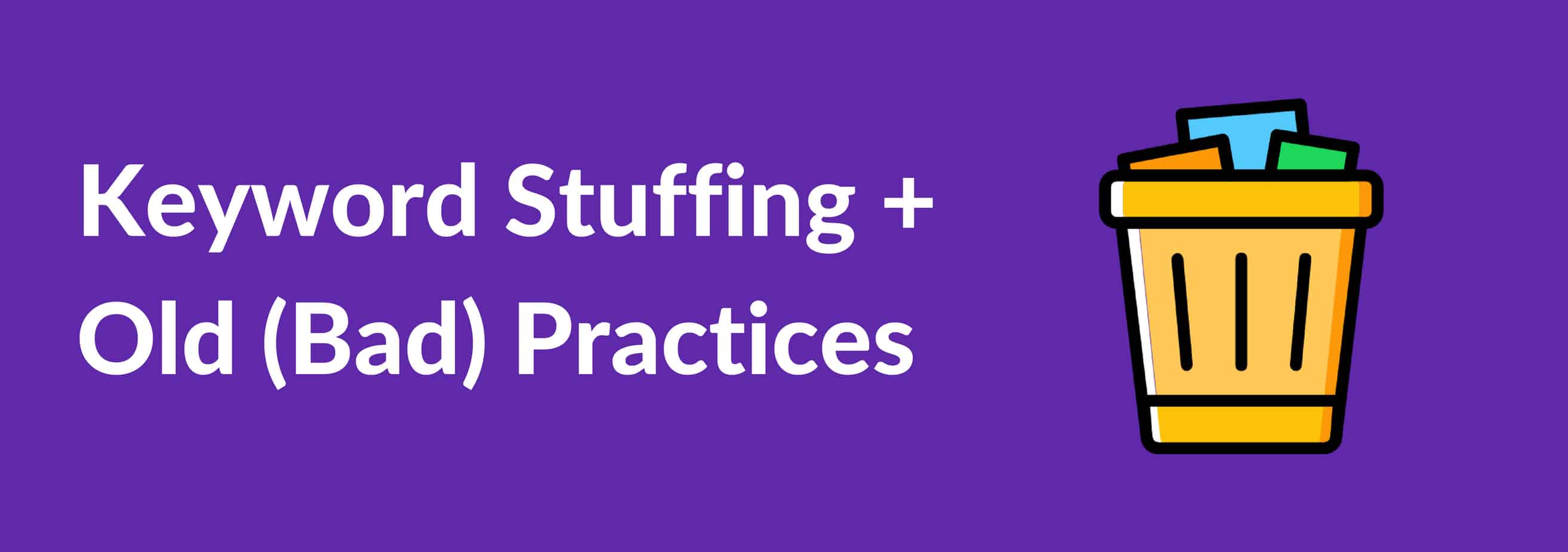
SEO has evolved a lot over the last few years. What used to work like gangbusters now either doesn’t work or it will get your site penalized, not to mention turn off Human readers.
If you’ve read any amount online about SEO, you’ve probably encountered some out-dated tactics.
This chapter is all about what not to do, no matter what.
I know I briefly mentioned bad outdated SEO practices in the introduction to this guide, but I want to make absolute sure your content is amazing and does well in Google, so let’s go into more detail on what not to do with your content.
Keyword Density Isn’t Everything
You might have heard the term keyword stuffing before but not been 100% clear on what it meant.
Here’s the thing.
Back in the day, people used to try to fit as many different versions of their target keyword into the content as many times as possible.
You can imagine what this did to the quality of the content that was ranking on page 1.
A burrito recipe blog post might say: “Here on my burrito recipe blog, you’ll find the best burrito recipes to make your burrito recipes the best burrito recipes.”
This, my friend, is keyword stuffing.
Yeah. Blech.
That may have worked pretty well back in the day to get you on page 1 of Google, but can you imagine seeing that in a top 3 result now?
Hell no!
So if you’re seeing anything telling you how important keyword density is, tell them to stuff it (see what I did there?).
Keyword density is not as important as it used to be.
Should you use your target keyword in your content? Of course! Should you make sure it’s in the headline and a subheader or two? Totally! But don’t get all hung up on hitting the perfect keyword density or having your exact keyword in your content a certain number of times. That’s the fast track to no-bueno-zone.
Don’t Keyword Stuff Your Image Tags Either
Did you know Googlebots don’t have eyeballs? I know, who knew, right?
Google doesn’t have a way to actually see and interpret images the way that humans can, so it uses information in the image titles and alt text to figure out what it’s all about.
Most of the time, image titles default to whatever the file name was when you uploaded the picture. For example, IMG_2345
Now, that obviously says nothing about the image. So you want to go into the media file on your site and change the image title to something a little more helpful.
Alt text (or alternative text) is a tag you add to an image to come up if for some reason the image can’t be seen.
Primarily this was designed for visually impaired users who use screen readers to better understand the image and its function on the page. It also comes into play if the image can’t be loaded for some reason.
Plus, Robots use it to better understand the context of the page content and to properly index the image and page.
Keeping the first and second purposes of the alt text in mind, it’s important to make sure the alt text actually makes sense when you read it. Don’t just make it a jumble of words. And don’t just stuff it full of keywords.
If you’re targeting a particular keyword, this is a great place to put it (or a related and relevant term) to have the images helping you say “Hey Google! This is what this page is about!”
But be careful.
If you try too hard to stuff keywords into your image titles and alt texts, you could over-optimize your images and get your page penalized.
For example, if you’re writing an article about 8 Killer Breakfast Recipes for the Paleo Newbie, you’re probably going to have some images of actually cooking the recipes, and you’re probably going to have some filler images of healthy looking people.
If you follow best practice, you’re using the image tags to accurately and succinctly describe the images. The terms “paleo recipe”, “paleo pancakes”, and “paleo breakfast” are probably going to occur naturally in some of the pictures.
Over-optimization, in this example, would be using those terms in every single picture, whether or not it showed paleo food, even the ones of healthy looking people.
Basically, only add keywords to the image tags when it’s relevant to the image and can happen naturally.
Forget About Keyword Tags
If you knew anything about SEO 5-10 years ago, you might know what meta keyword tags are (were) and how important they used to be.
If you have no idea what meta keyword tags are, please skip this section and don’t taint your beautiful brain with this knowledge, because people need to forget about them and act like they never existed.
Once upon a time, when search engines were innocent and young and SEO practitioners were shady as hell, there was something called “keyword tags”.
When someone really wanted traffic on their page, they would create a meta tag in the backend code that listed all the keywords this page was targeting.
But there were also black hat SEOs who put in other high traffic terms that had nothing to do with the page’s content, just to get the page ranking and get some traffic.
Remember our burrito recipe blog post example from before? If a black hat SEO person was running that page, the keyword tag might have looked like this: <meta name=“keywords” content=“burrito recipe, burrito recipes, burritos, best burrito recipe, free porn videos, free tv shows” />
Gasp! Swoon!
But seriously. People really did this. So Google got smart and did away with keyword tags all together.
Most people have caught on, so this keyword tags aren’t talked about as much online, but I still hear about them from some less tech savvy people sometimes.
(When I first started working in SEO, my dad said “Oh yeah, keyword tags and stuff. I know about SEO.” *facepalm*)
Chapter 3: How to Make Googlebots (and Humans) Love You by Writing High-Quality, In-Depth Content

The most important thing you can do for SEO and to benefit your readers is to write high-quality, in-depth content.
In this chapter, we’ll talk about exactly what the hell that means.
If you’re writing the best damn content about your topic, and it’s better than anything your keyword competitors are ranking with, odds are it’s gonna be pretty long.
In this awesome study that Brian Dean did at Backlinko, longer content ranks higher in the search engine results.
If your content is long and in-depth, and you want it to compete in search engines, it needs to be at least 1,500-2,000 words long. (On average, content that ranks on the first page of Google has 1,890 words).
Now, it’s not really about the length.
You can’t just keep typing to fill the word count and not offer extra value, after all. The reason for the statistically long content is that to offer enough value that your content ranks well on Google, it’s probably gonna rack up some words.
So don’t focus on word count.
Focus on going as in-depth as you humanly can.
Here are some of my favorite ways to do that:
Go deep into pros and cons.
Let’s say you’re writing a review of a product or technique that’s commonly used in your industry. One of the best ways you can beef up your content and offer more value is to go into pros and cons.
And I don’t mean briefly touch on them in quick bullet points. I mean really get your hands in the mud and sort out the advantages and disadvantages of the thing in detail.
Maybe you even do this for multiple different versions similar products.
Detail all the different possible sides or elements of the topic.
Basically, if you could make it a series of blog posts and it would make sense, instead, try making it one long-ass in-depth post.
This could be covering all the different options out there for getting something done, like all the different email marketing softwares.
Or it could be different methods or styles of doing something, like different ways you could become a digital nomad.
Lay out all the step by steps involved, in immense detail.
If you’re doing a tutorial, don’t just lay it out recipe style, regular step by regular step.
Do itsy bitsy baby steps.
This has the added bonus of de-intimidating your topic. For example, if you write about getting out of debt, breaking down your tips into the tiniest possible steps helps make it feel more achievable.
Lay out case studies or examples of what you’re discussing.
This is an excellent way to beef up your content. It doesn’t just increase your word count and take your content more in-depth.
It also increases your perceived expertise because it shows that you’re teaching something on your blog that gets results.
And it shows your audience that whatever you’re case studying is possible. That they can do it too.
Chapter 4: How Keyword Research Can Get You More Traffic Than You’d Get Without It

A lot of people choose their topic and write their content before doing their keyword research, but this is all wrong if your focus for that content is to kill it on Google.
It’s important to research topics and keywords before you start writing so that you know what questions people are asking, and also how difficult it will be to rank high in search results for that keyword.
In this chapter, let’s talk about how to pick an effective keyword to write content around.
Pick a Linkable Topic Before You Start Researching
Because backlinks are one of the other top 3 ranking factors for Google, when you’re trying to write content that will be super SEOtastic, it’s important to choose a topic that influencers in your niche are going to be interested in linking to.
Otherwise, you’ll be spending all this time and energy writing about something that won’t generate any backlinks or get anyone’s attention, so it’ll be difficult to get it to climb the ranks of Google.
Now, it’s not enough to write the bejeezus out of a good topic. You have to do some research to find the write primary keyword to write around and optimize for.
The 3 Elements of Keyword Research
Whenever you do keyword research, there are 3 things you need to pay attention to when you look at the list of keywords in front of you:
Search Volume
This refers to the average number of searches that happen per month for this particular keyword.
Keyword Difficulty
Every good keyword research tool has an algorithm that calculates approximately how difficult it will be to get your page to rank for the keyword. These are usually on some kind of scale, where lower is easier and higher is more difficult.
Searcher Intent
Unfortunately there’s no way to calculate this; you just have to go with your gut. But it’s important to keep the searcher’s intention in mind when you’re choosing a keyword.
If you’re not sure, it’s a good idea to check out what’s on the first page for the term. Sometimes you’ll find that the results are something completely different from what you’re writing about, so it might be worth scrapping that keyword and finding something else.
How to Pick the Right Primary Keyword for Your Content
Unless you’re a mega corporation with bazillions in marketing budget, it’s best to avoid the keywords that have super high traffic volume.
The reason for this is that these are usually super super competitive, and they also tend to be not very specific to your target market.
At the same time, don’t pick a super low-volume, long-tail keyword for your primary keyword. Long-tail keywords are important, but they have no place as primary keywords. It just makes no sense to try to rank for something that nobody searches for.
Instead, pick a keyword with volume somewhere in the middle.
If your site is fairly new, it might be smart to pick something with a relatively low keyword difficulty. As your site gains authority online, you’ll have an easier and easier (or at least less difficult) time ranking for the more difficult terms!
As you pick your main keyword, make note of any related keywords that could be subtopics or could be incorporated into the content, as well. They’ll be handy when we get to Chapter 6.
Best Keyword Research Tools
Some keyword research tools are free, some are freemium (meaning they are free to a point and lead into a paid product), and some are paid.
Regardless of cost, the best tools have a strong database that they draw from to show you stats, and they have a way to score keyword difficulty.
Here are some of my favorite keyword research tools at each price point:
Google Keyword Planner (free)
A list of keyword research tools wouldn’t be complete without mentioning the Google Keyword Planner. This free tool is actually part of Google’s AdWords program, so it’s designed for people researching to put paid ads up in Google. But you can still use it for regular SEO.
The search volume information is all expressed in ranges, rather than specifics, but it can still give you a pretty good idea of things.
It also has no Keyword Difficulty algorithm, since it was designed for SEM (paid search engine marketing) rather than SEO (just the organic search engine optimization). The best way to hack this is to use CPC (cost-per-click) and competition as vague indicators of keyword difficulty.
It’s free to make an account, and you don’t have to start a campaign to use it (but they like to make you feel that way).
 Moz Keyword Explorer (freemium)
Moz Keyword Explorer (freemium)
Moz has a growing database to support their keyword research tool, and their user interface is super intuitive and easy to grasp.
They also uniquely have another score other than Keyword Difficulty, which they call Priority. It combines Difficulty and Organic Click Through Rate to indicate whether or not a term would really be worth it. Handy!
This is a freemium product, so it’s free up to a point. It’s part of the Moz Pro product, which is Moz’s SEO tool and includes more than just the Keyword Explorer.
 Ahrefs (paid)
Ahrefs (paid)
This is the tool that I use now. It’s a comprehensive SEO tool, so it’s more than just a keyword research tool. Their search volume data is deep and gets delightfully specific, and there are lots of different ways that they suggest related keywords.
My favorite part of the keyword research portion of AhRefs is the SERP overview. It shows you the first 10 results for the keyword you’re researching (so the whole first page) as well as their backlink profiles, how much traffic each page gets, how many keywords they rank for, and the top keyword for each page. So much keyword inspiration!
If you want a simple rinse-and-repeat system to do your keyword research and find the perfect keywords for your content, I've got just the thing. Check it out here.
Chapter 5: How to Compete on the SERPs by Analyzing What's Ranking

The key to ranking on the first page for your keyword is to offer even more value than the content that’s already there.
In order to do this, you’ve got to look at what your ranking competitors have written and see how you can out-do them.
In this chapter, I’ll tell you about my favorite ways to analyze the content that’s already ranking.
How to Analyze the Search Engine Results Page
Once you’ve got your primary (or target) keyword, analyzing competitor content is as simple as doing a Google search for your keyword and seeing what’s ranking on page 1 (and maybe page 2 if you’re feeling thorough).
There are a few different ways you can compete with them, in addition to the value they offer in their content.
Let’s start with what we can see on the SERP (search engine result page):
How are the title and description formatted?
This is especially important in the top handful of results. The title and description are going to have a lot of impact on click-through-rate, which is a big part of what puts a result at the top of the page.
What have they got going for them? What cues can you take from them that you could apply to yours too?
Is there any Schema markup making a result stand out more than others?
Schema markup is what gives certain results things like star ratings or displays them in a special way, and it can be a handy way to stand out in the SERP results.
So far there’s no indication that schema markup directly affects your ranking, but it does seem to have an effect on click-through-rate, which does directly affect your rankings.
For example:
When I search for “paleo desserts”, I get a whole bunch of blog posts about the topic, mostly list posts.
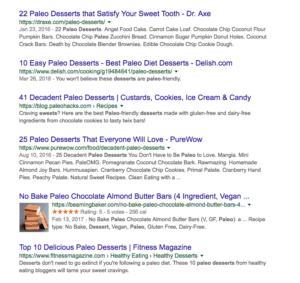
But one of the results is a recipe that has a thumbnail picture, a 5 star rating, and shows the number of calories!
It’s not in the top 3 results, but you better believe it caught my eye. And that’s all because of Schema markup.
What about special Google things like a Featured Snippet or People Also Ask?
Have you ever done a search and at the very top of the page is a big box that answers your question right away?
Those are part of the Google Knowledge Graph. And a lot of the time, those are Featured Snippets.
What’s a Featured Snippet?
Well, if a piece of content answers a question super succinctly, they’ll sometimes use it as a Featured Snippet up at the top of the results.
In the “paleo desserts” example, at the very top of the page was a giant box that listed several different paleo dessert options. And the whole thing was lifted from a blog post.
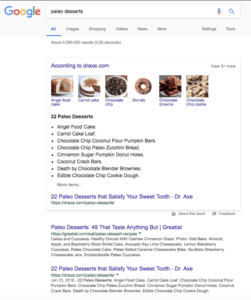
See? And that’s some serious SERP real estate.
So sometimes it’s worth thinking about how you could write or format your content, or what you could include in your content to try to get a Featured Snippet.
Another similar Google feature you could do this for is the “People Also Ask…” feature.
How to Analyze the Competition's Domain Authority
It’s a good idea to check the Domain Authority of the pages you’ll be competing against.
What’s Domain Authority?
Domain Authority (DA) is a score that indicates how powerful a particular domain is going to be in SEO.
Originally devised by Moz, it takes a whole bunch of different factors into account, like linking root domains, number of backlinks, age, popularity, etc. On a scale from 1 to 100, the higher the DA, the stronger the SEO power.
How to check your competition's Domain Authority
Normally this would be difficult without a paid SEO tool, but lucky for us there’s this handy dandy tool called the MozBar, and it’s totally free!
MozBar is a free Chrome extension that helps you analyze your competition right on the result page, so you won’t even have to go anywhere.
-
- Make sure you’re using the Chrome browser (obviously you can’t use a Chrome extension on Safari…)
-
- Download and install the extension.
-
- If you use the Moz Keyword Explorer, sign into the MozBar with the same account. If you don’t have a Moz account, create one (it’s free).
- Do a Google search for your keyword and bada bing bada boom, you can see the DA of each result, right there on the page!
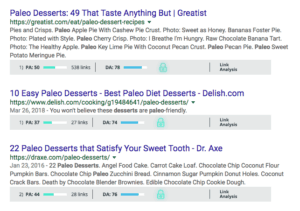
You can also see the Page Authority (PA), which is similar to DA except that it’s for that specific page rather than for the whole website. And you can see the number of backlinks pointing to that page.
These are all (DA, PA, and Links) super handy in assessing how stiff the competition is for the particular keyword you searched.
Chapter 6: How to Structure Your Content to Rank for Multiple Keywords and Get Extra Traffic

The cool thing about writing in-depth content is that you’re writing so much that you’re probably going to rank for multiple keywords that are closely related to your topic.
One way to make sure you’re targeting multiple keywords is by using them as inspiration for your subsections and subtitles.
We’ll talk about how in this chapter.
What the heck?? Targeting multiple keywords?
I bet you thought you were supposed to target one keyword per post.
Nope! That’s one of the benefits of writing long in-depth content above 1,500 words.
Start the process by doing your keyword research for your main primary keyword, but by going in depth, you’ll also be ranking for several long-tail keywords as well.
What about targeting long-tail keywords as my primary?
You might have seen advice floating around online that you should target long-tail low volume keywords in your articles, but this advice is outdated and ineffective.
It used to be that an article targeting “how to write for SEO” would be able to rank for that exact phrase, but not “writing for SEO”. Which is pretty dumb, right? It’s basically the same topic.
So Google cracked down and made some algorithm changes like Hummingbird and RankBrain.
So now, Google can recognize the context of your article, not just the keywords you target. Which means the results for “writing for SEO” and “how to write for SEO” are basically the same!
But it’s not just different variations of your main keyword that you can rank for. If you’re writing a reeeeally in-depth post, you can use other long-tail keywords as inspiration for different sections of your article and try to target them too!
Use Long-Tail Keywords to Fill Gaps in Your Content
Sometimes when you’ve been working for what feels like a million years on an epic piece of content, it can be hard to tell up from down let alone see any gaps in your content.
What do I mean by content gaps? Maybe there’s a concept that needs to be explained more clearly for a reader who’s not an expert like you, or maybe there’s a particular aspect of the topic that just hadn’t even occurred to you but could be valuable to include.
These kinds of gaps are perfectly plugged with content inspired by long-tail keywords.
It makes your content more in-depth, more detailed, and more thorough. Which is like taking Google out for dinner to wine and dine.
How to Find Content Gaps and Long-Tail Keywords
One way to find these is by checking the Wikipedia page for the topic you’re writing about. Depending on the topic, the table of contents can give you tons of ideas of sub-sections to include!
For example, let’s say you were writing an in-depth piece about croissants, and you’d already included lots of information about how to make them. Then you take a look at the Wikipedia page for croissants to see if there are any content gaps or things you could include you hadn’t thought of.
Here's the Table of Contents for the Wiki page about croissants:
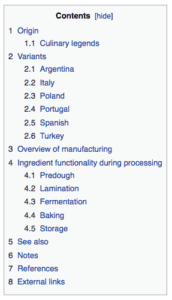
There’s a whole multi-section about variations of croissants in different countries! There’s a boat load of added content inspiration!
And when you check out the See Also section, it links to a few pages of modern variations of croissants, like cronuts and cruffins.

That could give you inspiration for a whole other section in your croissant content that your competitors would never have thought of and would never have found in a keyword research tool.
Who’da thunk??
Chapter 7: How to Keep Humans Reading Your Stuff by Writing Skimmable Content

There are few things more intimidating to online readers than walls of text. It’s important to keep them reading by making your content skimmable.
While making your stuff skimmable doesn’t directly impact your SEO, it does impact the way readers interact with your content, which does impact your SEO.
This is especially true with the extra importance of Google RankBrain in 2018.
So. Skimmable content. Let’s talk about how.
Short Intros
The intro is probably one of the most important parts of your content in getting readers to stay and keep reading.
Those first few sentences are what they read in the 3 seconds you have to convince them to stay. So you either quickly and succinctly tease what the content is about, why it’s important, and how it will benefit them, thus piquing their interest so they keep scrolling.
Or you lose their interest by being too wordy, too vague, or getting off topic, and they click the back button and pogo back to the search results, which is bad for your SEO.
Short paragraphs and sentences
Remember when your 5th grade teacher taught you that paragraphs are 5-6 sentences long or longer?
Forget all that.
Try to break up your text into short paragraphs, no more than 2 or 3 sentences each.
It helps keep the flow and pace moving forward, and breaks up your text to allow for more white space, which is very reader-friendly.
Lots of subheaders
It’s important to break up your text into clear sections with subheaders. This helps readers if they want to skim to a section that’s more relevant to them. And it means that they can skim the whole article and get the general gist just by reading the subheaders.
Bonus:
Properly formatted subheaders (with H2, H3, and even H4 tags) are also good places to put long-tail and LSI keywords to indicate to Googlebots that your content is in depth on your topic.
Bullet points and lists
Another great way to make your content skimmable is with bullet points and lists.
Now I don’t mean lists, as in doing a list post. That’s a whole different animal.
I mean lists as in a small list that quickly covers the information in a few lines. This is handy for listing examples of things, or quick step by steps to something in a subsection.
For example, in Chapter 5 I quickly made a numbered list of the steps to install and start using the Chrome extension MozBar.
Conclusion
So that’s my Ultimate Guide to Writing for SEO!
Now it’s your turn. What did you think? Do you have any strategies you use to write SEO-tastic content?
Let me know by leaving a comment below!
Icons made by Smashicons from www.flaticon.com is licensed by CC 3.0 BY
Free SEOtastic Flowchart & Checklist
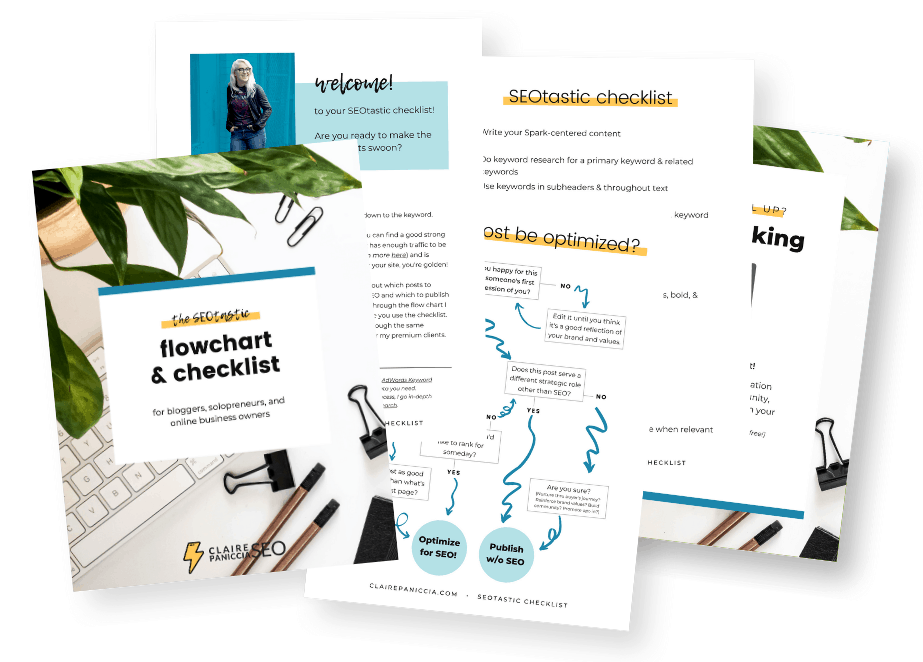





Wow, thank you for the information. I can see how some advice that I received before today is not good.